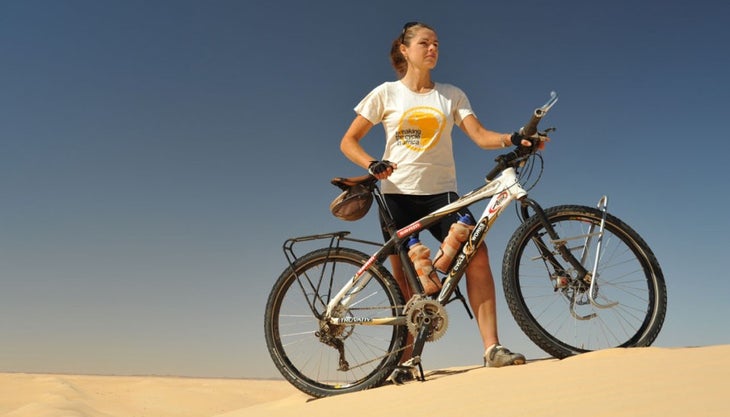Kate Leeming first started biking because she was thinking of doing a triathlon—but also because she just wanted to build fitness. The Australian had grown up playing hockey and squash; she was athletic and when she lived in the UK she dreamed of traveling by bike. She wanted to build up her fitness and get out on the road. She never got around to that triathlon, but instead found a whole new world on two wheels.
At first, she started just by biking through Spain. Then she biked through the Mediterranean and then through Norway. “I didn’t really know what I could do. I didn’t have the confidence,” she said.
It wasn’t until she met British polar explorer Robert Swan that she realized her biking could be so much more. It could be an expedition, a modern-day exploration, a chance to highlight issues in these places she rode through.
First up: a five-month, 15,000-kilometer unsupported ride across Russia. She then spent nine months circling her native Australia and get to know places off the beaten path. She biked from the western most point in Senegal to the eastern edge of Somalia to raise awareness of extreme poverty as part of her Breaking the Cycle campaign. Most recently, she made the first 1,000-mile bicycle journey down Namibia’s Skeleton Coast—documented for OutsideTV.
Every one of her trips has a bigger goal or purpose. In Africa, her trip was an official expedition of the U.N. In Russia, she wanted to aid the children of Chernobyl. She’s also written two books about her experiences.
Next up–after she gets back from a multi-month trip biking 6,000 kilometers across the middle of Australia: Becoming the first person to ride across Antartica and bring her Breaking the Cycle educational efforts with her. How does she do it—keep riding through snakes and sand and ice and lions and wind?
She shared some tips right before she headed out again.

Lesson #1: Gear matters. So does preparation.
When you want to ride across the Outback in Australia you need a bike that can make it through anything. Leeming has four fat bikes she tests for different conditions and that were specially designed for her with an all-wheel-drive-style system—so that she can get out of the sand or snow no matter what.
Up next in her plans is cycling across Antartica, which means she’s been testing not just bikes but also the right gear and clothing. Every test trip to Norway or the Arctic she fine-tunes things a little bit.
She also has to make sure she has all the logistics covered: How much food and water will she need? Is it going to be supported or self-supported? Even if it’s a supported journey, there are spots where you can’t access supplies for days or even weeks—what do you need to bring with the crew and how much? In the Skeleton Coast, she also had to get permits to go through a closed off diamond mining area that had otherwise been locked down for decades.
“The cycling is the simple bit,” she said.
Lesson #2: Pace yourself to fitness.
Funny enough, with all the planning and logistics that go into an expedition, the last few weeks often involve very little training. She’ll get in some shorter rides, but has to rely on the knowledge that the bulk of her training was done before—and then she can simply pace herself and build over the days.
“You just have to ride into it,” she said.
That can mean knowing that the first day or first week will be tough, but you can get through it if you pace conservatively and just keep moving forward. She likes to ride one gear easier up hills than she feels like she should, to keep her legs fresh. And when she’s riding through deep sand, which can make it hard to even hit a 50-kilometer daily target, she knows she just has to keep going.
Lesson #3: One step at a time can get you across any desert.
At times biking down the Skeleton Coast, she was going “a walking pace.” With the winds and the deep sand, not to mention the lions and diamond minds, it was slow. That’s when she had to do something any triathlete would be familiar with: break it down into smaller goals. And then just back that up, day after day after day.
Even when it gets hard, though, she said, she never wants to quit–because she knows so clearly what it motivation is and why she’s doing this.
Lesson #4: It’s really about the journey.
“The bike is really my tool for adventure,” she said.
Yes, it’s about the bike—but it’s never really about the bike. She designs her routes to tell a story or highlight a place. For example when she traveled west-to-east across Africa she stopped and visited different projects and organizations along the way to show the amazing things happening in the region. And when she traveled around Australia it gave her a chance to get to know the people in her home country.
“Traveling on a bike really helps to bring out the best in people,” she said. You can to see a whole different part of the world than what you can see by car. It connects you to the land—for better or worse.
You can watch the first episode below of ‘Diamonds in the Sand,’ which follows her expedition along the Skeleton Coast. Stream the rest of the series on-demand at outsidetv.com and the free Outside TV App
"explorer" - Google News
May 18, 2021 at 03:09AM
https://ift.tt/3bRpL1t
What Triathletes Can Learn from This Global Cycling Explorer – Triathlete - Triathlete
"explorer" - Google News
https://ift.tt/2zIjLrm
Bagikan Berita Ini














0 Response to "What Triathletes Can Learn from This Global Cycling Explorer – Triathlete - Triathlete"
Post a Comment